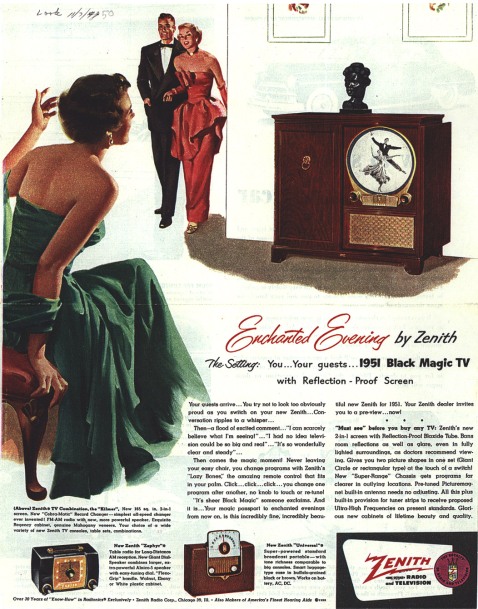
Enchanted Evening by Zenith – Ad #TV0825
John W. Hartman Center for Sales, Advertising & Marketing History
Duke University David M. Rubenstein Rare Book & Manuscript Library
http://library.duke.edu/digitalcollections/adaccess_TV0825/#
Our group was chosen to do the fourth and final ad about the Zenith television. When we discussed the ad amongst ourselves, we went through and attempted to make points for the audience, constraints, and exigence, as well as the logos, pathos, and ethos, and essentially made bullet points for each category. The main audience for this ad would be made up of a group of socialites. It is advertised as an “enchanted evening” and revolves around the premise that you will invite your regular high brow guests over and you might all sit back with a glass of Château Le Pin and watch the daily news. It’s possible to tell this from the exigence of the ad, such as the happy smiling people who invoke a sense of warmth, unity, and a good time. The big, red fancy text is eloquent and a color of power and authority, and the calligraphy is stenciled to look fancier than a typical Times New Roman font. Even things not having to do with the television at all are fancy, like the statue on top of the television set or the armchair the woman in green is sitting on. Obviously not everyone can afford this, so the constraint attempts to deal with the poorer people by including two hand radios that, while still fancy, are a bit cheaper and easier to acquire. This in turn affects the secondary audience of the ad, which is meant to target those who want the television as a distraction and a lazy activity, and who want to plop their kids in front of it so they can focus on a single task without disruption.
The logos deals with the good things that will come from owning this television set, which is that friends will come over and you will throw parties and have a good time without necessarily having to leave the comfort of your living room. With this comes the pathos, which tugs on the emotional heartstrings of the audience. People want to be liked and popular; it’s the human condition. So, when we see something that will increase our likability, we desire it beyond other things. People desire to be the woman in the green dress who is having guests over to share a good laugh and a great time. They want to be the ones with the new and exciting gadgets, so the ethos comes into play, convincing the customer they are the best company to buy from because they are reliable and make good products. In this ad, much of that reassurance comes from the wording that is used. It uses the line, “Zenith’s new 2-in-1 screen with Reflection-Proof Blaxide Tube”, which sounds confusing, but in a good way. “2-in-1” is always a good way to go, because people love getting more for their money. “Reflection-Proof Blaxide Tube” is a fancy line with “blaxide” being the most interesting word. It took me some digging through Google to even remotely find out what it was (the “Blaxide Tube”, which reduced glare), but instead of just using “Reflection-Proof”, they added “Blaxide Tube” to make it sound more sophisticated. They add that there is a remote, which seems like it was a big selling point at the time. Even at the bottom, there is subscript that says, “Over 30 years of ‘Know-How’…”, which tells the customer that they’ve been refining televisions for long enough to have made a good system. The effect of television didn’t stop there though. In the 1950’s, the television was effectively a status symbol. It lacked many channels and HD quality, but it showed who had extra wealth to spend and who didn’t, and from there on it was easier to deduce who had gotten an education and who had made it up the corporate ladder to make such a fine income. For these reasons, this Zenith television ad seems to display a well-balanced use of each of the aforementioned ideas.
